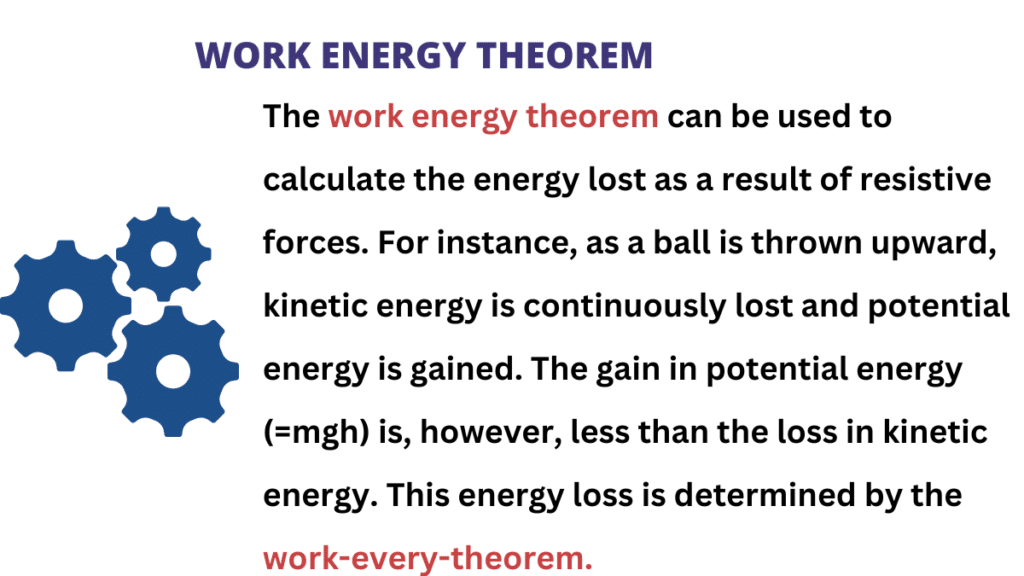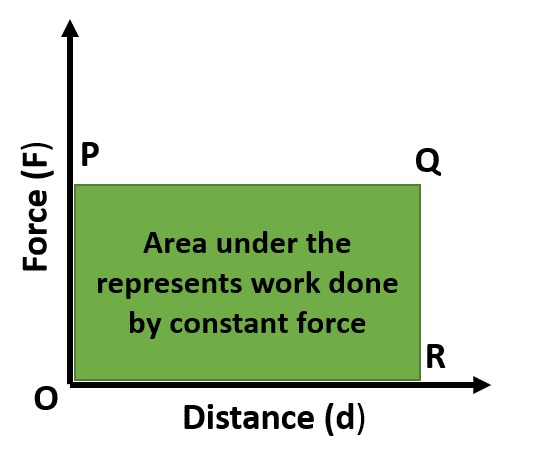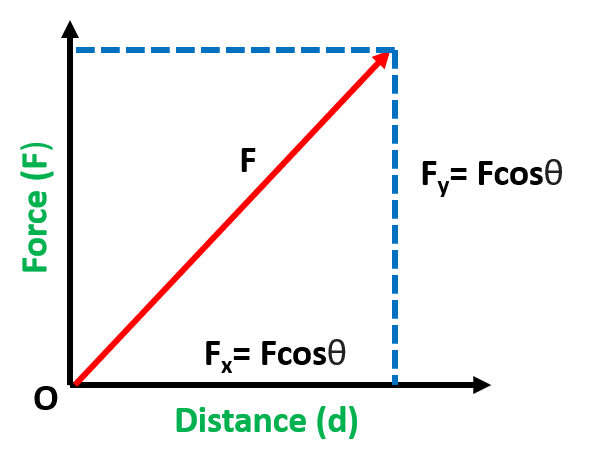According to the work-energy theorem, the work done by the sum of all forces acting on an object equals the change in kinetic energy of the object (or) the net work done on a system equals the change in kinetic energy.
Table of Contents
Derivation of Work-Energy Theorem
Consider an object moving with constant acceleration, along a straight line. The equation F = ma (Newton’s second law) expresses the relationship between net force and acceleration, and the particle’s displacement d can be calculated using the kinematics equation (vf2=vi2+2ad)
The work done of the net force is calculated as the product of its magnitude and the displacement of the particle (W=Fd).
The translational kinetic energy of a body is equal to one-half the product of its mass, m, and the square of its velocity, v, or (1/2)mv2.
Work done = K.Ef-K.Ei (Network done = change in Kinetic Energy)

Work Energy Theorem Real Life Examples
The work-energy theorem states that the work done on an object is equal to the change in its kinetic energy. This principle can be seen in many everyday examples:
- Lifting a heavy object: When you lift a heavy object, you are doing work on it. This increases the object’s potential energy, which is converted into kinetic energy when you carry it or move it.
- Throwing a ball: When you throw a ball, you do work on it by applying a force over a distance. This increases the ball’s kinetic energy, causing it to move through the air.
- Pushing a shopping cart: When you push a shopping cart, you do work on it by applying a force over a distance. This increases the cart’s kinetic energy, causing it to move across the floor.
- Jumping on a trampoline: When you jump on a trampoline, you do work on it by applying a force to compress it. This increases the trampoline’s potential energy, which is then converted into kinetic energy as you bounce.
- Pedaling a bicycle: When you pedal a bicycle, you do work on the pedals by applying a force over a distance. This increases the kinetic energy of the bike, causing it to move forward.
These are just a few examples of how the work-energy theorem is evident in everyday life. The principle can be applied to a wide range of physical systems to help explain and understand the relationship between work and energy.
What is Work?
Work is defined as the product of force (F) and displacement (S) in the force’s direction.
Work done = force multiplied by displacement.
The unit of work is the joule. One joule is the amount of work done when a force of 1 Newton is applied over 1 meter of distance.
Graphical Representation of Work Done By A Constant Force
The area under a force-displacement curve represents the work done by a constant force.
Explanation: Consider a constant force F applied on an object and displaces it through the distance d along the x-axis. The force is constant along the y-axis.
When constant force F and displacement d are in the same direction.
W = Fdcosθ (F and d are in the same direction so θ is zero)
W = Fd

On the graph, the green shaded area in the figure is OPQR which is also Fd. Hence area under the force-displacement curve measures the work done.
Work done by Inclined force
Consider a force (F) applied to an object. The force F is making an angle θ with the surface on which the body is moved as shown in the figure at left. The applied force F can be resolved into its perpendicular components Fx and Fy.
Fx = Fcosθ ——— (1)
Fy = Fsinθ ——— (2)
When Force and displacement are not parallel then only the x-component of force (Fx) causes the body to move on the surface.
W = F x d since Fx = Fcosθ
W = Fcosθ d = Fdcosθ

Simple Definitions of Work Energy Theorem
The work-energy theorem states that the net work done on an object is equal to its change in kinetic energy.
In simpler terms, it means that when a force acts on an object, it can transfer energy to the object, either increasing or decreasing its motion.
More specifically, the work-energy theorem can be stated as follows:
- The net work done on an object is equal to the change in its kinetic energy.
- In mathematical terms, this can be expressed as: Wnet = ΔK Where Wnet is the net work done on the object, ΔK is the change in its kinetic energy.
- In essence, the work-energy theorem provides a way to understand the relationship between the work done on an object and the resulting change in its motion, specifically in terms of its kinetic energy.
What is Energy?
Energy is defined as the ability to work. Potential energy, kinetic energy, thermal energy, electrical energy, chemical energy, light energy, and nuclear energy are all examples of energy. Energy is what causes things to change and move. It’s all around us and comes in a variety of shapes and sizes. Cooking food, driving to school, and jumping in the air all require energy.
Summary
- Work-energy theorem states that the work done by the sum of all forces acting on an object equals the change in kinetic energy of the object.
- Work is a scalar quantity and its unit is Joule.
- Unit of work is one joule. Work is one joule if a force of 1 Newton is applied across a distance of 1 meter.
- The kinetic energy of a body is equal to one-half the product of its mass, m, and the square of its velocity.
More Interesting Topics
Can Force be Negative?| Easy Explanation
Kinetic Energy Formula
Angular Displacement Formula| Easy Examples
Centripetal Acceleration| 9- Easy Examples
Energy-The Ability to do Work
Frequently Asked Questions
1. What is the work-energy theorem in simple words?
According to Work-Energy Theorem, the net work done on a body is equal to the change in kinetic energy of the body.
2. What is the static pressure of liquid?
In fluid dynamics, static pressure refers to the amount of pressure exerted by a fluid that is not moving. When employing a pressure head, it is commonly measured as a force divided by an area, or in length units.
3. PV diagram
The pressure-volume diagram (abbreviated as the PV diagram) is a graphical depiction of pressure variations with respect to volume in a closed system. P-V diagrams can be used to determine a system’s efficiency and the work done by a system or on the system.
4. What is a Solar thermal power plant?
A solar thermal power plant absorbs and concentrates sunlight to generate the high-temperature heat necessary to generate electricity.
5. What is an alternative fuel vehicle?
An alternative fuel vehicle (AFV) is a vehicle that operates on fuels other than gasoline and diesel. Alternative fuels are obtained from non-petroleum sources.
6. Is solar power and solar energy the same thing?
Solar energy and solar power are two different terms for the same phenomenon. Solar energy is a type of electricity generated by the sun. Both use the sun’s rays to heat water, power turbines, and generate energy.
More Interesting Topics
- BCl3 Lewis Structure in four simple steps - November 1, 2023
- PH3 Lewis Structure in four simple steps - October 8, 2023
- PF3 Lewis structure in four simple steps - September 24, 2023



